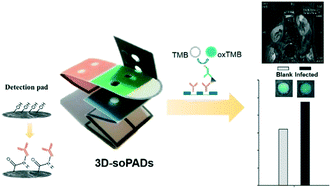Three-dimensional origami paper-based device for portable immunoassay applications†
Abstract
In this study, we demonstrate a three-dimensional surface-modified origami-paper-based analytical device (3D-soPAD) for immunoassay applications. The platform enables the sequential steps of immunoassays to be easily performed using a folded, sliding paper design featuring multiple pre-stored reagents, allowing us to take advantage of the vertical diffusion of the analyte through the different paper layers. The cellulose substrate is composed of carboxymethyl cellulose modified with N-(3-dimethylaminopropyl)-N′-ethylcarbodiimide hydrochloride and N-hydroxysuccinimide, which provide covalent bonding sites for bio-recognition molecules. After the optimization of the operation parameters, we determined the detection limit of the 3D-soPAD for human immunoglobulin G (HIgG) which can be as low as 0.01 ng mL−1, with a total turnaround time of 7 min. In order to study the long-term storage of the platform, anti-HIgG horseradish peroxidase (aHIgG-HRP) conjugates were stored by freeze-drying in sugar matrices composed of 10% sucrose/10% trehalose (w/w%) on the paper device, retaining 80% of their activity after 75 days of storage at 4 °C. To evaluate the performance of the paper device using real samples, we demonstrated the detection of protein A (a biomarker for Staphylococcus aureus infection) in highly viscous human synovial fluid. These results show that the proposed 3D-soPAD platform can provide sensitive, high-throughput, and on-site prognosis of infection in resource-limited settings.



 Please wait while we load your content...
Please wait while we load your content...